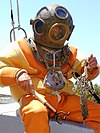Combined gas law

In each law, properties circled are variable and properties not circled are constant.
| Continuum mechanics | |||||||
|---|---|---|---|---|---|---|---|
|
Laws
|
|||||||
|
|||||||
The combined gas law is a gas law that combines Charles's law, Boyle's law, and Gay-Lussac's law.[1][2] [3]There is no official founder for this law; it is merely an amalgamation of the three previously discovered laws. These laws each relate one thermodynamic variable to another mathematically while holding everything else constant. Charles's law states that volume and temperature are directly proportional to each other as long as pressure is held constant. Boyle's law asserts that pressure and volume are inversely proportional to each other at fixed temperature. Finally, Gay-Lussac's law introduces a direct proportionality between temperature and pressure as long as it is at a constant volume. The inter-dependence of these variables is shown in the combined gas law, which clearly states that:
| “ | The ratio between the pressure-volume product and the temperature of a system remains constant. | ” |
This can be stated mathematically as:
where:
- P is the pressure,
- V is the volume,
- T is the temperature measured in kelvins,
- k is a constant (with units of energy divided by temperature).
For comparing the same substance under two different sets of conditions, the law can be written as:
The addition of Avogadro's law to the combined gas law yields the ideal gas law.
Derivation from the gas laws[edit]
Boyle's Law states that the pressure-volume product is constant:
Charles's Law shows that the volume is proportional to the absolute temperature:
Gay-Lussac's Law says that the pressure is proportional to the absolute temperature:
The algebraic manipulation cannot be done directly because Boyle did his experiments with constant temperature, Charles did them with constant pressure and Lussac did them with constant volume, therefore a more exact interpretation of the prior equations would be:
with not being constants, but appropriate functions, mimicking the respective dependencies.
Keeping this in mind, to carry the derivation on correctly, one must imagine the gas being altered by one process at a time. Say, starting to change only pressure and volume, according to Boyle's law, then:
- After this process, the gas has parameters: , and
Then changing volume and temperature, according to Charles' law:
- After this process, the state of the gas is: , and
Finally, pressure and temperature are changed obeying Gay-Lussac's Law:
- After this process, the state is: , and
Applying algebra yields:
- From equation (4) follows
- substituting into equation (5) yields
- and finally substituting from (6) into (8) results in:
- which simplifies to:
or in other words
where k is a physical constant, and the dependencies have vanished.
Applications[edit]
The combined gas law can be used to explain the mechanics where pressure, temperature, and volume are affected. For example: air conditioners, refrigerators and the formation of clouds. Also used in fluid mechanics and thermodynamics.
See also[edit]
References[edit]
- ↑ Raymond, Kenneth W. (2010). General, organic, and biological chemistry : an integrated approach (3rd ed.). John Wiley & Sons. p. 186. ISBN 9780470504765. Retrieved 29 January 2019. Search this book on

- ↑ Mikulecky, Peter J.; Hren, Chris (2014-11-26). Chemistry Workbook For Dummies. John Wiley & Sons. ISBN 9781118940051. Search this book on

- ↑ Bettelheim, Frederick A.; Brown, William H.; Campbell, Mary K.; Farrell, Shawn O. (2009-01-05). Introduction to General, Organic and Biochemistry. Cengage Learning. pp. 146–149. ISBN 9780495391128. Search this book on

See also[edit]
- Raff, Lionel. Principles of Physical Chemistry. New Jersey: Prentice-Hall, 2001.
External links[edit]
- Interactive Java applet on the combined gas law by Wolfgang Bauer
This article "Combined gas law" is from Wikipedia. The list of its authors can be seen in its historical and/or the page Edithistory:Combined gas law. Articles copied from Draft Namespace on Wikipedia could be seen on the Draft Namespace of Wikipedia and not main one.


























